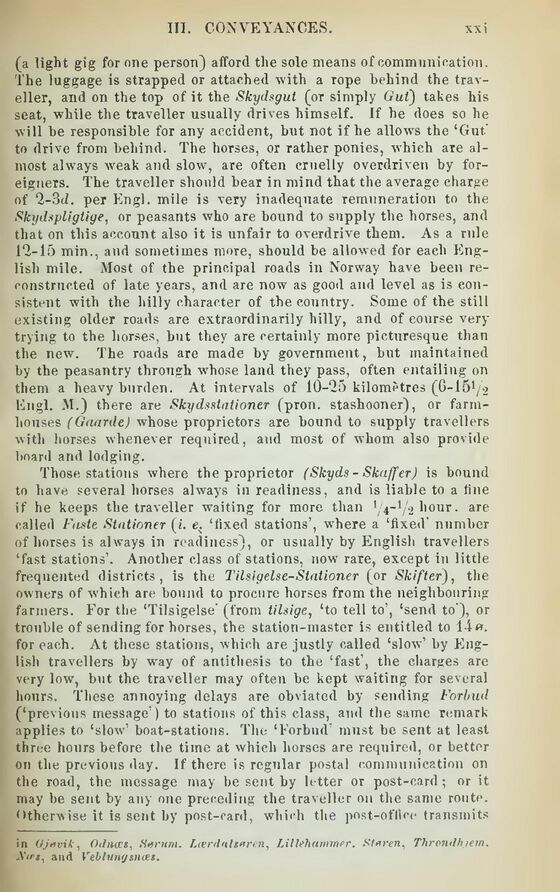
Full resolution (JPEG) - On this page / på denna sida - Introduction - Pages ...

<< prev. page << föreg. sida << >> nästa sida >> next page >>
Below is the raw OCR text
from the above scanned image.
Do you see an error? Proofread the page now!
Här nedan syns maskintolkade texten från faksimilbilden ovan.
Ser du något fel? Korrekturläs sidan nu!
This page has been proofread at least once.
(diff)
(history)
Denna sida har korrekturlästs minst en gång.
(skillnad)
(historik)
(a light gig for one person) afford the sole means of communication.
The luggage is strapped or attached with a rope behind the
traveller, and on the top of it the Skydsgut (or simply Gut) takes his
seat, while the traveller usually drives himself. If he does so he
will be responsible for any accident, but not if he allows the ‘Gut.’
to drive from behind. The horses, or rather ponies, which aie
almost always weak and slow, are often cruelly overdriven by
foreigners. The traveller should bear in mind that the average charge
of 2-3d. per Engl, mile is very inadequate remuneration to the
Skydspligtige, or peasants who are bound to supply the horses, and
that on this acconnt also it is unfair to overdrive them. As a rule
12-15 min., and sometimes more, should be allowed for each
English mile. Most of the principal roads in Norway have been
reconstructed of late years, and are now as good and level as is
consistent with the hilly character of the country. Some of the still
existing older roads are extraordinarily hilly, and of course very
trying to the horses, but they are certainly more picturesque than
the new. The roads are made by government, but maintained
by the peasantry through whose land they pass, often entailing on
them a heavy burden. At intervals of 10-25 kilometres (G-IÖ1/*
Engl. M.) there are Skydsstationer (pron. stashooner), or
farmhouses (Gaarde) whose proprietors are bound to supply travellers
with horses whenever required, and most of whom also provide
board and lodging.
Those stations where the proprietor (Skyds - Skaffer) is bound
to have several horses always in readiness, and is liable to a tine
if he keeps the traveller waiting for more than 1 4-1 ■> hour, are
called Faste Stationer (i. e. ‘fixed stations’, where a ‘fixed’ number
of horses is always in readiness), or usually by English travellers
‘fast stations’. Another class of stations, now rare, except in little
frequented districts, is the Tilsigelse-Stationer (or Skifter), the
owners of which are bound to procure horses from the neighbouring
fanners. For the ‘Tilsigelse’ (from tilsige, ‘to tell to’, ‘send to’), or
trouble of sending for horses, the station-master is entitled to 14u.
for each. At these stations, which are justly called ‘slow’ by
English travellers by way of antithesis to the ‘fast’, the charges are
very low, but the traveller may often be kept waiting for several
hours. These annoying delays are obviated by sending Forbud
(‘previous message’) to stations of this class, and the same remark
applies to ‘slow’ boat-stations. The ‘Forbud’ must be sent at least
three hours before the time at which horses are required, or better
on the previous day. If there is regular postal communication on
the road, the message may be sent by letter or post-card; or it
may be sent by any one preceding the traveller on the same routp.
Otherwise it is sent by post-card, which the pnst-oflicp transmits
<< prev. page << föreg. sida << >> nästa sida >> next page >>